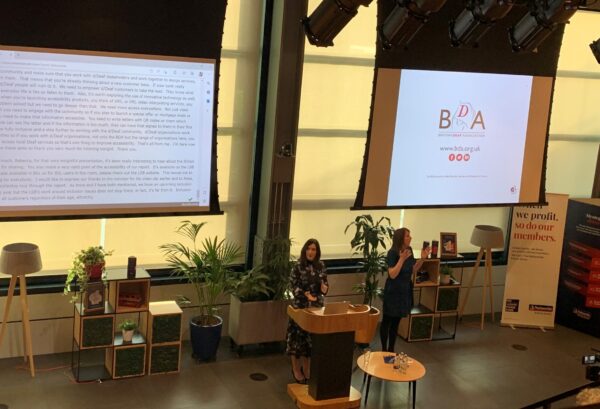LSB Head of Insight and Engagement, Anna Roughley, recently spoke at the Collaboration Network Conference in Manchester, on the priorities for ensuring good customer outcomes during the cost-of-living crisis.

*The notes below may differ from those delivered on the day*
Hello, my name is Anna Roughley and I am the Head of Insight and Engagement at the Lending Standards Board – the LSB. I’m really pleased to have been invited to talk to you today about something which is set to affect us all, and something that isn’t going to drift from the news any time soon – the cost-of-living crisis. More specifically, I want to talk about people, priorities and prevention. Ensuring that people, your customers and clients, are at the heart of everything you do, and the power of prevention in this crisis – including preventing financial difficulty, customer harm and distress, and reducing the impact of the crisis on customers. Although I’m focussing today on the cost-of-living crisis, everything I’m going to talk about is important for business as usual activities and other external factors that are affecting customers now or in the future, such as Brexit, the pandemic, and the war on Ukraine.
As the primary self-regulatory body for the banking and lending industry, our independent oversight team oversee the major UK banks, lenders, credit card providers, debt collection agencies and debt purchase firms’ adherence to our Standards and Codes. We see first-hand across this sector areas of good practice and areas where development is needed in relation to customer outcomes. We also see the interaction between other sectors, like utilities and telecoms, where collaboration and development could also improve prevention and deliver greater protection for customers.
I’ll go on to talk about these areas of best practice and areas for possible improvements later on, and hopefully there will be some insights for you to take away. To start off with, I’d like to set the scene by looking at the current landscape.
The current landscape
The last few years have been filled with uncertainty and instability. The fact we are sat here together in person, in itself feels a little unusual after years of lockdowns caused by the pandemic. As individuals and organisations, we all had to adapt quickly to a new way of life and working. And those adaptations continue to be needed as the cost-of-living crisis also takes its toll.
There is an unprecedented level of rising prices and cost uncertainty in a number of sectors, with people having to adapt their budgets and spending on a near monthly basis. Many people who weren’t previously in financial difficulty now are, with many reviewing their spending and cutting out life’s ‘luxuries’ such as TV packages and holidays to make their income stretch further. Those already on the edge of difficulties have nowhere to turn to protect themselves from rising prices.
I recently read a report that indicated that less than half of UK households have either no savings at all or not enough to cover a large unexpected expenditure, and the most common step taken by households to ‘make ends meet’ since the start of 2022 was to save less money than usual – with this affecting 51% of households. We can quickly begin to see how those previously unaffected, may very quickly need help. Customers need to know where they can turn to for support, and that is where your organisations come in, and critically, where prevention measures need to be brought in to reduce the impact on the customer, rather than picking up the pieces afterwards.
Prevention in practice – customer communication
So I’ve mentioned prevention many times, but what do we actually mean when we talk about prevention, and how do we achieve it? I’m going to break down it down into different parts – good customer communication, good training and intervention, a good use of soft skills, signposting and support, and good collaboration – all leading to better customer outcomes.
For those who don’t know, we set and oversee adherence to sets of best practice Standards and Codes, that financial services firms sign up and adhere to, to drive good customer outcomes. Among those, are the Standards of Lending Practice for personal customers, which many of you here many be familiar with. One of these Standards refers to money management and sets out that customers should be helped with ‘managing their finances through proactive and reactive measures.’ This is more vital than ever and applies not just to those working in the financial services, but all service providers. We have to be ready to provide the right support at the right time – through intervention and prevention. This is achieved through a number of methods including ‘proactively encouraging customers’ to get in contact if there has been any change in their circumstance which may for example make paying their bills or making repayments challenging. It means using the information you have available to identify signs of difficulty, and training your teams to spot and be aware of potential difficulties. It means responding positively and proactively with customers so you can help to prevent the impact of the crisis or their circumstance from developing or worsening.
I mentioned encouraging proactive customer contact. Very often customers are not aware of the support available to them before they need it, or they may not understand why sharing that information may be important. Engaging and informative customer communications play an important part in this for all service providers. By reviewing your communications channels – letters, leaflets, websites, social media channels etc, and ensuring they mention and address the cost-of-living crisis, you can help to ensure your customers have the information they need to be able to reach out and ask you for help, preventing the situation from worsening.
Another example where good communication goes hand in hand with prevention, is when it comes to scams. Scam education from financial services, utilities, telecoms, social media companies, is absolutely vital. We know that scams are on the rise – many of us here have probably been targeted by a scammer, or may know someone who has been scammed. We know that scams are out there, and we often think it won’t happen to us because we think we know what to look out for, but the hard truth is that we are all vulnerable to scams, because the level of sophistication used by scammers are reaching new heights.
Citizens Advice recently revealed that whilst over 55s are most likely to be a target of a scam, people under the age of 34 are actually five times more likely to fall for a scam. And men are apparently twice as likely to fall for a scam than women. Those statistics may shock you, but hopefully they reinforce how easy it is to be scammed, and why it is so important that scam education needs to be stepped up. During the pandemic we saw good examples of proactive, relevant and specific scam awareness campaigns from financial services firms and consideration was given to positioning of information and also ease of access. You can see here the importance of encouraging contact when circumstances are expected to change or have changed throughout the cost-of-living crisis. Being informed, or able to find the relevant information swiftly, can be the catalyst for action and better outcomes. I’ll go on to talk about prevention in the scam space in a little more detail shortly.
In terms of identifying signs of distress and training your teams to look out for these, organisations may analyse data or look for patterns that lead them to believe that a certain group of customers may be at an increased risk of falling into difficulty. A customer may disclose a situation, or provide some information that may indicate they may be or are experiencing difficulties. To use an example, a customer whose gas and electric bill has bounced, after years of never having done so, may not have enough money in their account to pay their direct debit. Although this may be a one off and may not be an indication of being in difficulty, it could be. The challenge is then to either know what to do with this information and how to positively address the concerns, or how to effectively gather enough information, through further probing, to be able to provide the right support.
We know from our work in Emerging Risk Forums, where we bring financial services firms together to discuss industry risks and opportunities, that some firms have tried proactive contact but not found it to deliver the changes in behaviour or resolutions it set out to. This could be because these conversations can be challenging; for example, contacting customers proactively and explaining concern about overspending/lack of income or some other trigger, or probing further as it could provoke a negative reaction from the customer. And so we want to ensure that staff have the knowledge, skills, confidence and flexibility to support customers showing signs of or in difficulty.
Prevention in practice – training
Refreshed training for front line agents will help ensure they have the skills and confidence they need to identify and support customers. It starts with understanding the various ways the cost-of-living crisis is impacting customers.
This crisis is unique, and so business as usual training cannot be relied upon. In part, this is because of the scale of the crisis and the fact it is effecting so many sectors and elements of people’s lives. It must not be assumed that because the cost-of-living crisis is universal, that all front line agents will be able to understand how customers are impacted and therefore training needs to be adapted or refreshed, to ensure it takes account of the crisis. It’s important to note that this is always applicable – not just for the crisis. External factors constantly evolve and affect customers, and so training must evolve with it. Without refreshed training, organisations are at risk of missing key indicators of difficulty and a lost opportunity to intervene and provide support that may have potentially prevented exacerbating the customers situation.
Part of training for those engaging with customers should also involve how to have those effective conversations I spoke about earlier. Active listening and demonstrating empathy are two key components of an effective conversation. They create a connection between an agent and a customer, and when we connect, we can build a relationship and trust, even if it is just for a moment in time. With trust comes openness, and it is through that openness that an agent can really get to the heart of what is happening for the customer and help produce the best outcome for them moving forward.
I mentioned earlier that the insights we would talk about today are not only applicable in the cost-of-living crisis. So let’s look at another example now, and for this I’m going to use a situation very fresh in our minds – the pandemic. This is another situation where people experienced new or heightened vulnerabilities. Many people were left with reduced hours or without work for example, leading to financial difficulties, possible challenges with keeping up with bills and repayments, and also possible feelings of worry or embarrassment. If this situation arose again now, by understanding the impact of the pandemic on people’s situations, service provider agents would be better able to equip themselves for these challenging conversations with customers and it will give them the confidence to ask the right questions to provide the best help going forwards.
Training should focus on asking open questions and actively listening to the customer. This is empathy in action. Empathy is not a series of phrases in response to the answer a customer has given. Empathy is only felt if demonstrated through action, active listening, the way we respond, and recognising and referring back to what we have already been told. Behaving in this way also gives the agent the opportunity to recognise times when the customer may be omitting important information or may be embarrassed to talk about a subject and normalising it – creating a safe space to talk.
Being live to how customers may be impacted by the current crisis, together with these soft skills, will help agents to properly support customers and deliver better outcomes. Using soft skills to better engage with the customer and understanding their circumstances enables all of us to better tailor a solution for them, hopefully putting something in place that prevents their situation worsening. At the very least, it will help them to feel heard, understood and supported.
Prevention in practice – signposting
As I mentioned earlier, prevention can’t always mean stopping something from happening, but instead it’s about reducing the impact. And so what can service providers do when someone has fallen into a challenging situation? Well this is where reducing the impact on them really comes into play, and one way this can be achieved, is through effective signposting.
Signposting is an important step in supporting customers when they require help beyond the remit of an organisation. No-one expects a bank, water company or gas provider to be an expert in all situations that require support – it’s just not feasible, but what you can do, is signpost to those organisations who can provide that support. Ensuring that information about third party organisations is up to date, including looking, where possible, at local support that customers could be signposted towards, can prove vital to supporting a customer.
The positioning and timing of signposting is also really important if it is to be effective and bring around positive engagement. It should take place at the relevant time in the call, the agent should understand what the organisation does and critically does not do, the customer should be clear on how that organisation can help them with their needs and be given the time to actually engage with the third party.
Prevention in practice – collaboration
The final thing I’d like to speak to you about today is the importance of collaboration both within sectors, and across sectors. I’m going to focus on a particular area where collaboration is key, because I believe it’s relevant for all of us here today. And that is scams.
You may well be thinking: why is scam prevention relevant to me? If that isn’t clear now, hopefully it will do over the next few minutes.
In 2021, there were 345,137 authorised push payments (APP) made to fraudsters, criminals – totalling £583.2m. I can tell from the shocked look on some of your faces that you’d agree this number is huge. APP scams occur when a customer is tricked into sending money to a person they believe is a legitimate payee, but is in fact a scammer.
Now more than ever customers need to feel they can trust their service provider, and there are many things happening that are challenging this, such as APP scams. Scammers exploit the good relationships that customers have with their providers by impersonating them, eroding that trust.
How many of you here today have received a scam text from your water company, or a postal company, asking for a payment? It dilutes your trust in those companies, even though those texts don’t come from the legitimate service provider. If you have received a text from your ‘water company’ (ie a scam text), but then get a legitimate call from your water company, you’re understandably less likely to be open with them, because you are more guarded.
The more that can be done to prevent scams from happening and the more that can be done to protect the trust between customers and service providers, the better. Because as we have spoken about today, the trust between customers and providers is vital to producing open, honest conversations and good outcomes. We have such a range of organisations represented here today – from banks and lenders, to tech firms and utility providers. This is relevant to you all, because scammers will use all of your organisations and the relationships you have with customers to try and succeed with their crimes. Protecting that trust is one incentive for stepping up scam prevention measures, but there are many, many more too, and so many of them relate to preventing customer harm.
Anyone can fall victim to an APP scam, and factors such as life events, physical and mental health, caring responsibilities and so on can make us more susceptible to falling for an APP scam. Scammers prey on situations lie the cost-of-living crisis, where people are experiencing new or heightened vulnerabilities and looking for ways to stretch their finances.
These scams have long lasting impacts on their victims. In fact, recent statistics from Canada Life highlighted that of people they surveyed who had been a victim of an APP scam or who knew someone who had, 37% of people felt like their trust in others had vanished, 47% were left feeling foolish, and 55% said it had taken a toll on their mental health. These feelings don’t go away.
Preventing scams from happening in the first place is vital, because it is the only way to truly avoid this customer harm.
Early intervention and prevention are paramount to putting a stop to customer harm, and in order to successfully prevent scams from taking place, collaboration is crucial. That is because scammers socially engineer their victims to fall for their deceit, by building relationships and trust with them, tapping into accounts to gather information, and hacking phone systems to feign their identity. This means that often by the point the customer comes to make the payment that they believe is legitimate, they are so convinced that this is real, that no amount of warning from their bank can break the spell they are under.
By point of payment it’s just too late.
That is why other organisations must join the fight and play their part; social media companies preventing scammers from making accounts; phone companies preventing scammers from spoofing phone numbers; and utilities companies preventing customers from falling for impersonation scams. There are so many sectors involved and so many opportunities to intervene. Scammers used joined up approaches to make their crimes successful, and it’s that joined up approach that we also need to do. All industries need to, as a matter of urgency, look at the part they play, independently and together, in the scam journey, identifying as many opportunities as possible to intervene.
In conclusion
I’m going to wrap up shortly and take the time to answer some of your questions.
In summary, today we have focussed on the role we can all play in supporting our customers during this difficult time and beyond, through often simple but effective measures, such as refreshed training, good signposting, open conversations, and collaboration with others. It’s not about starting from scratch, but instead building on the frameworks, polices and processes we have, and being flexible and adaptive to situations that affect us all.
I hope that some of the insights and considerations I have shared today will empower your organisations to take some of these steps to empower your teams to support your customers as effectively as possible. Our organisations exist to serve our customers. If the pandemic taught us anything, it’s that we can do more with what we have – and so now is the time to really shine a light on our internal practices and understand where we can improve our prevention measures to provide the best outcomes for our people.









